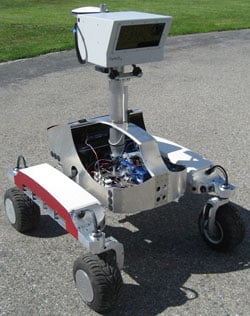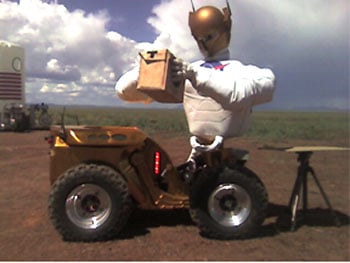Original URL: https://www.theregister.com/2007/10/27/robo_developer_nasa_and_robots/
NASA extends olive branch to robots for moon mission
Can't we all just get along?
Posted in Science, 27th October 2007 12:02 GMT
Robo Developer NASA intends to get more touchy-feely with robots before they take off for the moon again.
Their attempts to reach out to the robot community really took off in the last few years when NASA changed its exploration focus from the international space station to returning to the moon. They even made an dramatic Hollywood-like "preview" of the mission to prove it. (And if you want to show something is real, Hollywood is definitely the way to go.)
"You probably noticed the majority of the footage is CG," said Terry Fong, a NASA Director speaking yesterday at the Robo Development conference in San Jose. "I guarantee in 10 to 15 years that this can be replaced with real footage."
Unlike the previous Apollo moon missions, NASA will be investing heavily in robotics this time round. And so, NASA developed the Human-Robotics Systems Project which, Fong said. is one of its most heavily funded programs in 10 years.
The main themes of the Human Robotics System program are surface mobility, surface handling, and interestingly, human-systems interactions.
Some are more equal than others
The relations between humans and their robot counterparts are of great importance to NASA. For instance, there's no "side of the road" to threaten to pull a rocket over to if the bots are getting rambunctious. But it goes deeper than that.
"In a traditional interaction, a human is the user and the robot is a tool," said Fong. "This works great for some things, but not for others. We are trying to make humans and robots have more equal roles."
Sounds like dangerous talk. Those who lie down with robots wake up with critical errors.
"When robots run into trouble, they don't ask for help or seek advice. That's something they need to do," said Fong. "Robots will need to overcome these limitations. Robots and humans need to support each other."
Fong believes that for successful space exploration, robots and humans need to function as partners. Robots need to understand how humans work as a team, and humans need to be comfortable functioning with them.
There's also the motivation of practicality. Fong said there's a clear need at NASA to eliminate the number and duration of unproductive EVA sorties to reduce mission cost and wasted crew time.
Robots can off-load repetitive but necessary tasks from the crew. They can also enhance mission architecture, by providing more flexible and greater range for exploration. The distance Apollo astronauts were allowed to venture from the landing site was limited to how far they could walk back in a cumbersome space suit. This obviously isn't a restriction for robots. Fong said the maximum amount of crew members they will send to the moon is four. This makes robots quite necessary for effective lunar research.
Humans and robots will need to get along. So NASA has been practicing. Over the years, the space organization has wrangled up a few fascinating specimens to help develop these solutions. For instance, there's K10:

Image courtesy NASA
This robot is an autonomous surveying robot. It's equipped with 3-D laser scanners and ground-penetrating radar. The laser scanner is capable of mapping topographic features up to 3,280 feet away. The radar, which NASA's Jet Propulsion Laboratory developed, can map below ground as deep as 16.4 feet.

Image courtesy NASA
Robonaut is a humanoid robot designed by the Robot Systems branch at NASA in collaboration with DARPA. They built this mechanical abomination to function as an EVA astonaut equivalent for when they can't send in a human, but dexterity is needed. NASA has equipped the robot with both a soldering gun and a "human tracker" — so this will be the last thing many of you will see when the robot apocalypse comes.
In a video demonstration, Fong showed both K10 and Robonaut working with humans in a simulated construction environment. The humans put a panel in place and then asked Robonaut to solder it down. The robot agreed to the task in the same voice as Stephen Hawking's voice synthesizer and started the job. Next the crew asked K10 to shine a flashlight on a certain panel. The robot also complied. But looking at Robonaut's eyes, you could almost see...
No, it's best not to think about it.
More information and pictures about Robonaut are available at NASA's somewhat peculiar Robonaut website. ®